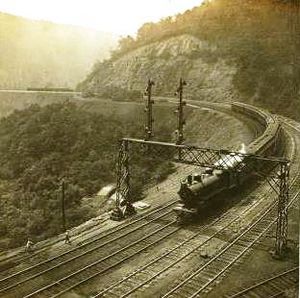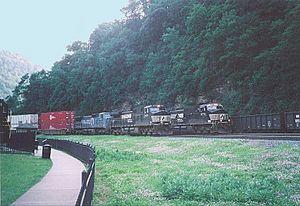Horseshoe Curve (Pennsylvania) facts for kids
|
Horseshoe Curve
|
|

A March 2006 aerial photo of Horseshoe Curve
|
|
| Location | Logan Township, Blair County, Pennsylvania |
|---|---|
| Nearest city | Altoona, Pennsylvania, U.S. |
| Built | 1851–1854 |
| Built by | Pennsylvania Railroad |
| Architect | John Edgar Thomson |
| NRHP reference No. | 66000647 |
Quick facts for kids Significant dates |
|
| Added to NRHP | November 13, 1966 |
| Designated NHL | November 13, 1966 |
The Horseshoe Curve is a famous three-track railroad curve in Blair County, Pennsylvania. It's shaped like a horseshoe, helping trains climb over the Allegheny Mountains.
This amazing curve is about 2,375 feet (700 m) long and 1,300 feet (400 m) wide. The Pennsylvania Railroad finished building it in 1854. It was a big step forward, making it easier for trains to cross the mountains. Before this, the Allegheny Portage Railroad was the only way, but it was much slower.
Over the years, different railroad companies owned and used the curve. These included Penn Central, Conrail, and now Norfolk Southern.
The Horseshoe Curve has always been a popular spot for visitors. An observation park was built in 1879 so people could watch the trains. This park was updated in the early 1990s, and a visitor center was added. The Railroaders Memorial Museum in Altoona helps manage the center. It has cool exhibits about the curve's history.
The Horseshoe Curve is also a very important historical site. It was added to the National Register of Historic Places in 1966. It was also named a National Historic Landmark that same year. In 2004, it became a National Historic Civil Engineering Landmark.
Contents
Where is the Horseshoe Curve?
The Horseshoe Curve is located about 5 miles (8 km) west of Altoona, Pennsylvania. It's in Logan Township, Blair County.
The curve is part of the Norfolk Southern Railway's main line, called the Pittsburgh Line. This line connects Pittsburgh and Harrisburg. The curve wraps around a dam and a lake. This lake is one of three reservoirs that provide water to Altoona.
The curve crosses two small valleys. These valleys were formed by Kittanning Run and Glenwhite Run. A highway, the Blair County Veterans Memorial Highway, goes through a tunnel under the curve.
How the Curve Works
Trains traveling west climb a steep hill from Altoona to Gallitzin. The steepest part of this climb is 1.85 percent. After passing the top of the Allegheny Mountains, trains go downhill to Johnstown.
The Horseshoe Curve itself has a slope of about 1.34 percent. It is 2,375 feet (724 m) long and about 1,300 feet (400 m) wide. The tracks bend 9 degrees and 15 arc minutes for every 100 feet (30 m). The entire curve turns a total of 220 degrees.
The curve helps trains gain a lot of height. For example, over a distance of 1,006 feet (310 m), a westbound train rises 133 feet (41 m). This kind of climb would normally be too steep for regular railroads. The Horseshoe Curve makes it possible!
The tracks are made of strong, welded steel. In the past, before dieselization (when trains started using diesel engines), the rails were sometimes swapped. This helped them wear evenly from the flanges of passing steam locomotives.
History of the Curve
Building the Railroad
In 1834, Pennsylvania built the Allegheny Portage Railroad. This connected Philadelphia and Pittsburgh using canals and inclined planes. It was part of the "Main Line of Public Works."
The Pennsylvania Railroad company was started in 1847. Its goal was to build a better railroad from Harrisburg to Pittsburgh. This new railroad would replace the old Portage Railroad.
Engineers had already found a good path for the railroad. But John Edgar Thomson, the Chief Engineer for the Pennsylvania Railroad, chose a different route. He picked a flatter path along the Juniata River. This path had a steeper climb west of Altoona. The Horseshoe Curve was designed to handle this steep climb.
Construction and Early Years
Work on the Horseshoe Curve began in 1850. It was built by hand, using only men with "picks and shovels, horses and drags." Workers built up the land over the first valley, cut through a mountain, and filled in the second valley.
The 31.1-mile (50.1 km) railroad line, including the Horseshoe Curve, opened on February 15, 1854. It cost about $2.5 million to build.
In 1879, the land inside the curve was flattened. This allowed for the creation of a park and observation area. It was the first park built specifically for watching trains! As more trains were needed, a third track was added in 1898, and a fourth in 1900.
From the 1860s until just before World War II, passengers could ride to a station near the curve called Kittanning Point. Two smaller railroads also connected here. They brought coal from nearby mines.
Reservoirs were built at the curve to supply water to Altoona. The first was in 1887, a second in 1896, and Lake Altoona by 1913. A road to the curve opened in 1932, making it easier for visitors to reach. A gift shop was built in 1940.
The Horseshoe Curve became very famous. It was shown in brochures and calendars. The Pennsylvania Railroad even put a picture of it on their stock certificates. Train conductors were told to announce the Horseshoe Curve to passengers. This tradition continues today on Amtrak trains.
World War II and Later
During World War II, the PRR moved many troops and supplies. The Horseshoe Curve was so important that it was guarded by armed soldiers.
In 1942, a group of spies from Nazi Germany tried to damage important places in the United States. Their plan was called Operation Pastorius. They wanted to destroy sites like the Horseshoe Curve. However, they were quickly caught by the Federal Bureau of Investigation (FBI).
Train traffic was busiest in the 1940s. More than 50 passenger trains passed through each day, along with many freight and military trains. After World War II, fewer people traveled by train as cars and airplanes became more popular.
In 1954, the Horseshoe Curve celebrated its 100th anniversary. For the celebration, 6,000 flashbulbs and 31 miles (50 km) of wiring were used to light up the area at night.
A steam locomotive, No. 1361, was placed at the park inside the curve in 1957. This engine was a K4-class locomotive, which were common passenger trains on the curve. The Horseshoe Curve was officially recognized as a National Historic Landmark in 1966.
In 1968, the Pennsylvania Railroad joined with the New York Central Railroad to form Penn Central. This company later went bankrupt. In 1976, the government took over and created Conrail. Conrail removed one of the tracks at the curve in 1981.
Locomotive No. 1361 was taken from the curve in 1985 to be repaired. An EMD GP9 engine, No. 7048, replaced it. This engine was painted to look like an old Pennsylvania Railroad train.
From 1990 to 1992, the park at the Horseshoe Curve was renovated. A new visitor center was built. In 1999, Conrail was split between CSX Transportation and Norfolk Southern. Norfolk Southern took over the Horseshoe Curve.
In 2004, the curve celebrated its 150th anniversary. It was lit up again with fireworks and searchlights, just like in 1954. That same year, it was named a National Historic Civil Engineering Landmark.
Current Operations
Today, the Horseshoe Curve is still a very busy part of Norfolk Southern's Pittsburgh Line. As of 2008, about 51 freight trains passed through each day. This doesn't include local trains or helper engines. Helper engines are added to the back of long trains to give them extra power going uphill and help them brake going downhill.
In 2012, Norfolk Southern reported that over 111 million tons of freight passed through the Horseshoe Curve each year. Amtrak's Pennsylvanian passenger train also uses the curve once a day in each direction. Freight trains can go up to 30 miles per hour (48 km/h) on the curve, and passenger trains about 35 miles per hour (56 km/h).
Visiting the Curve
The Railroaders Memorial Museum in Altoona manages the visitor center at the curve. The center is 6,800-square-foot (632 m2) and has many historical items. It also has a raised-relief map of the Altoona–Johnstown area.
To get to the curve, you can ride a 288-foot (88 m) funicular (a special cable car) or climb 194 steps. The funicular cars are painted to look like old Pennsylvania Railroad passenger cars. There's also an old "watchman's shanty" in the park.
The Horseshoe Curve is very popular with railfans (people who love trains). Sometimes, you can even see three trains passing each other at the same time! In 2012 and 2013, a historic steam locomotive, No. 765, traveled on the curve. This was the first time a steam locomotive had done so since 1977.
See also
- Altoona Curve, a local baseball team named after the railroad curve.
- List of funicular railways
- List of Historic Civil Engineering Landmarks
- List of National Historic Landmarks in Pennsylvania
- National Register of Historic Places listings in Blair County, Pennsylvania
- Raurimu Spiral
- Tehachapi Loop










